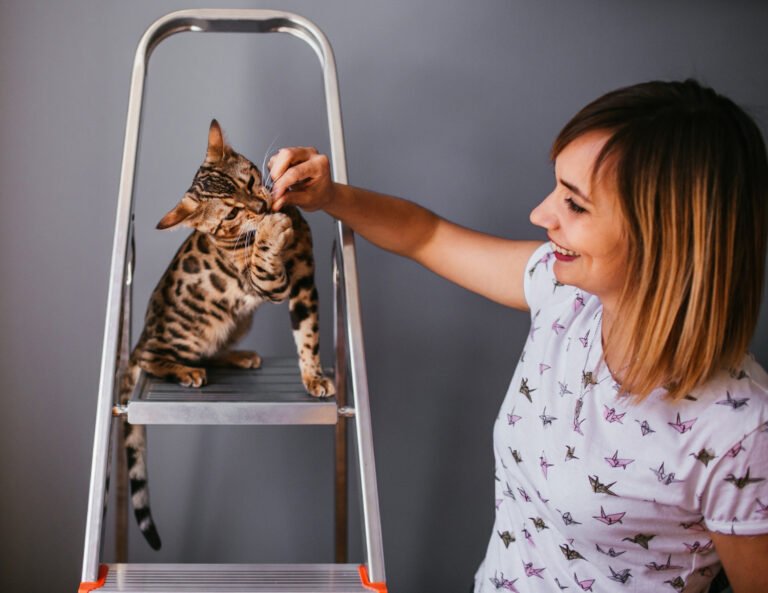Cats are known for their mysterious and independent nature. Understanding your cat’s behavior is crucial for effective training. Pay attention to your cat’s body language signals and behaviors, as they often communicate their needs and feelings through these cues. Here are some important signals how to train a cat.
Body Language Signals
Tail position, ear movement, and vocalizations can provide insights into your cat’s current mood and intentions. A cat’s tail held high indicates confidence and happiness, while a low or tucked tail suggests fear or anxiety. Ears pointed forward signal curiosity or playfulness, whereas flattened ears indicate fear or aggression. Listening to your cat’s vocalizations, such as purring, meowing, or hissing, can also help you gauge their emotional state.
Common Cat Behaviors to Interpret
Purring, kneading, grooming, and play behavior are all normal feline behaviors that reflect different emotions. Purring often indicates contentment, but it can also occur when a cat is anxious or in pain. Kneading, where a cat pushes its paws against a soft surface, usually signifies comfort and affection. Grooming is a self-soothing activity, while playful behaviors, like chasing and pouncing, showcase a cat’s natural hunting instincts. Understanding these behaviors is essential when learning how to train a cat effectively, as recognizing their emotions helps tailor the training approach to suit their needs
Importance of Building Trust with Your Cat
Trust is the foundation of successful cat training. Make sure to create a safe and comfortable environment where your cat feels secure. Spend quality time with your cat, offering gentle petting and treats to build a positive relationship. A trusting cat is more likely to respond well to training efforts.
Setting a Training Routine How to Train a Cat
Creating a Positive Environment
A positive environment is key to successful cat training. Designate a specific space for training and ensure it is free from distractions. Use positive reinforcement techniques such as treats and praise to encourage good behavior. A calm and consistent training area helps your cat focus and reduces stress.
Designating a Safe Space for Training
Choose a quiet area with minimal distractions to focus your cat’s attention during training sessions. This space should be comfortable and familiar to your cat, providing a sense of security. Having a designated training area helps your cat associate the space with learning and positive experiences.
Using Positive Reinforcement Techniques
Reward desired behaviors with treats, toys, or verbal praise to reinforce positive training outcomes. Positive reinforcement helps your cat understand which actions are rewarded, making them more likely to repeat those behaviors. Consistently rewarding good behavior builds a positive association with training sessions.
Consistency is Key to Training
Consistent training sessions and rewards help your cat understand what is expected of them and reinforce desired behaviors. Regular training at the same time each day establishes a routine, making it easier for your cat to learn and retain new commands. Consistency also helps prevent confusion and reinforces your cat’s learning.
Basic Commands and Tricks How to train a cat
Teaching Basic Commands
Start with basic commands to establish a foundation for further training. Teaching your cat to come, sit, and behave appropriately sets the stage for more advanced training techniques. Basic commands are essential for managing your cat’s behavior and ensuring their safety.
Training Your Cat to Come
Use a consistent cue and reward your cat when they come to you. Gradually increase the distance to reinforce the command. Practice this command regularly, using a cheerful tone and offering treats as rewards. Over time, your cat will learn to come when called, even from a distance.
Teaching Your Cat to Sit
Capture the sitting behavior naturally and reward your cat when they sit on command. Practice in short sessions to keep your cat engaged. Use treats or toys to lure your cat into a sitting position, then give the command and reward them. Consistent practice will help your cat learn to sit on cue. This is how to train a cat in natural way.
Encouraging Good Behavior with Treats
Treats are a powerful motivator for cats. Use them to reinforce positive behavior and create a positive association with training. Offer treats immediately after your cat performs the desired behavior to reinforce the connection between the action and the reward.

How to Train a Cat: Advanced Training Techniques
Teaching Advanced Tricks to train a cat
Once your cat has mastered basic commands, you can move on to teaching more advanced tricks. High-fiving, agility courses, and clicker training are fun ways to challenge your cat and strengthen your bond. Advanced tricks provide mental stimulation and physical exercise for your cat.
Training Your Cat to High-Five
Break down the high-fiving behavior into small steps and reward each progress. Be patient and consistent in your training approach. Start by encouraging your cat to touch your hand with their paw, then gradually shape the behavior into a high-five. Reward each step to keep your cat motivated.
Guiding Your Cat Through an Agility Course
Create a mini agility course with obstacles and encourage your cat to navigate through it. Use treats as rewards for completing each section. Agility training provides physical exercise and mental stimulation, helping to keep your cat healthy and engaged.
Incorporating Clicker Training
Clicker training pairs a clicking sound with a reward to mark desired behaviors. It can be a useful tool for shaping your cat’s behavior and teaching new tricks. Start by associating the clicker sound with treats, then use it to mark and reward specific actions. Clicker training helps clarify which behaviors are being rewarded.
Troubleshooting Common Training Issues
Addressing Behavioral Problems
Training a cat can have its challenges, but addressing common issues like aggression, fear, litter box problems, and destructive behavior can help you overcome obstacles and build a stronger bond with your pet. Understanding and addressing the root causes of these behaviors is essential for successful training.
Dealing with Aggression or Fear
Understand the root cause of aggression or fear and work on desensitization and counterconditioning techniques to address these behaviors. Gradual exposure to the source of fear or aggression, combined with positive reinforcement, can help your cat feel more comfortable and less reactive.
Handling Litter Box Issues
Maintain a clean and accessible litter box and address any underlying medical issues that may contribute to litter box problems. Ensure the litter box is in a quiet, private location, and clean it regularly to encourage use. If problems persist, consult a veterinarian.
Redirecting Destructive Behavior
Provide appropriate outlets for your cat’s natural instincts, such as scratching posts and interactive toys, to prevent destructive behaviors. Redirect your cat’s attention to these alternatives and reward them for using them. This helps protect your furniture and keeps your cat mentally and physically stimulated.
Learning how to train a cat involves understanding their behavior and addressing issues promptly. By tackling common problems like aggression, fear, litter box issues, and destructive behavior, you can create a harmonious environment for both you and your feline friend. Remember, patience and consistency are key to successfully training your cat.







1 thought on “How to train a cat? Step-by-Step Guide to Training Your Cat”